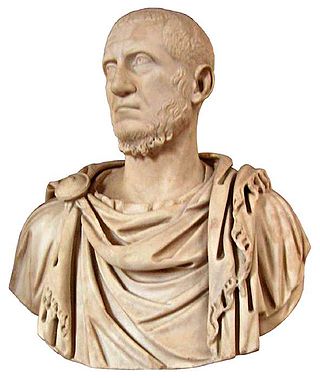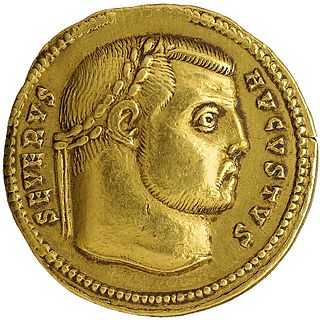Related Research Articles

Constantius II was Roman emperor from 337 to 361. His reign saw constant warfare on the borders against the Sasanian Empire and Germanic peoples, while internally the Roman Empire went through repeated civil wars, court intrigues, and usurpations. His religious policies inflamed domestic conflicts that would continue after his death.

Constantine II was Roman emperor from 337 to 340. The son of the emperor Constantine I, he was proclaimed caesar by his father shortly after his birth. He was associated with military victories over the Sarmatians, Alamanni and Goths during his career, for which he was granted a number of victory titles. He held the consulship four times – in 320, 321, 324, and 329.

Marcus Claudius Tacitus was Roman emperor from 275 to 276. During his short reign he campaigned against the Goths and the Heruli, for which he received the title Gothicus Maximus.

Glycerius was Roman emperor of the West from 473 to 474. He served as comes domesticorum during the reign of Olybrius, until Olybrius died in November 472. After a four-month interregnum, Glycerius was proclaimed as emperor in March 473 by Gundobad, the magister militum and power behind the throne. Very few of the events of his reign are known other than that an attempted invasion of Italy by the Visigoths was repelled by local commanders, diverting them to Gaul. Glycerius also prevented an invasion by the Ostrogoths through diplomacy, including a gift of 2,000 solidi.
Year 238 (CCXXXVIII) was a common year starting on Monday of the Julian calendar. At the time, it was known as the Year of the Consulship of Pius and Pontianus. The denomination 238 for this year has been used since the early medieval period, when the Anno Domini calendar era became the prevalent method in Europe for naming years.

Numerian was Roman emperor from 283 to 284 with his older brother Carinus. They were sons of Carus, a general raised to the office of praetorian prefect under Emperor Probus in 282.

Galerius Valerius Maximianus was Roman emperor from 305 to 311. While acting as Caesar under Emperor Diocletian, Galerius obtained victory warring against the Sassanian Empire, defeating Narseh at the battle of Satala in 298 and possibly sacking the Sassanian capital of Ctesiphon in 299. He also campaigned across the Danube against the Carpi, defeating them in 297 and 300. Although he was a staunch opponent of Christianity, Galerius ended the Diocletianic Persecution when he issued the Edict of Toleration in Serdica (Sofia) in 311.

Flavius Valerius Severus, also called Severus II, was a Roman emperor from 306 to 307, and a member of the Tetrarchy. He shared control of the western half of the empire with Constantine I, but spent most of his short reign in a civil war against the usurper Maxentius, who later killed him and took over Italy.

Flavia Julia Constantia was a Roman empress as the wife of Licinius. She was the daughter of the Roman emperor Constantius Chlorus and his wife Flavia Maximiana Theodora, and younger half-sister of Constantine the Great.

Minervina was either the first wife or a concubine of Constantine I, and the mother of his eldest son Crispus.
In the Battle of Châlons, fought in 274 on the site of modern Châlons-en-Champagne, France, Roman Emperor Aurelian defeated Emperor Tetricus I of the Gallic Empire, whose territories were rejoined with the Roman Empire after fourteen years of separation.
Calocaerus was a Roman usurper against Emperor Constantine I, who, in 334 AD, staged a short lived revolt in Cyprus. His revolt was quickly put down, and he was executed along with his commanders, by being burned alive.

Ino, renamed Aelia Anastasia was the Empress consort of Tiberius II Constantine of the Byzantine Empire, and Augusta from 578 until her death.

The civil wars of the Tetrarchy were a series of conflicts between the co-emperors of the Roman Empire, starting from 306 AD with the usurpation of Maxentius and the defeat of Severus to the defeat of Licinius at the hands of Constantine I in 324 AD.
Basilina was the wife of Julius Constantius and the mother of the Roman emperor Julian who in her honour gave the name Basilinopolis to a city in Bithynia.
Seleucus also known as Flavius Seleucus and Count Seleucus was a wealthy Greek rhetor who was a close friend of Libanius and the Roman emperor Julian.
Martinus or Marinus was caesar of the Byzantine Empire from c. 639 to 641. Martinus was the fifth son of Emperor Heraclius and Empress Martina, who was Heraclius' second wife and niece. Martinus was elevated to caesar, a junior imperial title that placed him on the line of succession, at some point between 638 and 640 by his father.

The Battle of Brescia was a confrontation that took place during the summer of 312, between the Roman emperors Constantine the Great and Maxentius in the town of Brescia, in northern Italy. Maxentius declared war on Constantine on the grounds that he wanted to avenge the death of his father Maximian, who had committed suicide after being defeated by him. Constantine would respond with a massive invasion of Italy.

The siege of Segusio or siege of Susa was the first clash of the civil war between the Roman emperors Constantine the Great and Maxentius in the spring of 312. In that year, Maxentius had declared war on Constantine, claiming to intend to avenge the death of his father Maximian, who had committed suicide after being defeated by him. Constantine would respond with an invasion of northern Italy.
References
- ↑ Salve Regina University (2002). "DIR--De Imperatoribus Romanis". Library of Congress . Washington, D.C.
- ↑ Internet Archive.
- ↑ Noel Emmanuel Lenski, ed. (2006). The Cambridge companion to the Age of Constantine. Vol. 13. Cambridge University Press. p. 106. ISBN 0-521-81838-9.